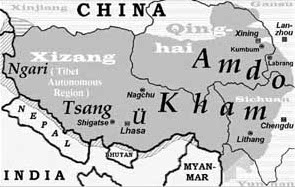
Dalai Lama is a title given by the Tibetan people for the foremost spiritual leader of the Gelug or "Yellow Hat" school of Tibetan Buddhism, the newest of the classical schools of Tibetan Buddhism. The 14th and current Dalai Lama is Tenzin Gyatso.
Tibetan Buddhism is the form of Buddhism named after the lands of Tibet where it is the dominant religion. It is also found in the regions surrounding the Himalayas, much of Chinese Central Asia, the Southern Siberian regions such as Tuva, as well as in Mongolia.

The Karmapa is the head of the Karma Kagyu, the largest sub-school of the Kagyu, itself one of the four major schools of Tibetan Buddhism.

The Gelug is the newest of the schools of Tibetan Buddhism. It was founded by Je Tsongkhapa (1357–1419), a philosopher and Tibetan religious leader. The first monastery he established was named Ganden, and to this day the Ganden Tripa is the nominal head of the school, though its most influential figure is the Dalai Lama. Allying themselves with the Mongols as a powerful patron, the Gelug emerged as the pre-eminent Buddhist school in Tibet and Mongolia since the end of the 16th century.

The Panchen Lama is a tulku of the Gelug school of Tibetan Buddhism. The Panchen Lama is one of the most important figures in the Gelug tradition, with a spiritual authority second only to Dalai Lama. "Panchen" is an abbreviation of "Pandita" and "Chenpo", meaning "Great scholar".

Lorenzo Fernando Lamas is an American actor. He is best known for his role of Lance Cumson, the irresponsible grandson of Angela Channing — played by Jane Wyman — in the soap opera Falcon Crest (1981–1990), for which he received a Golden Globe Award nomination for Best Supporting Actor – Series, Miniseries or Television Film.

Thubten Gyatso was the 13th Dalai Lama of Tibet.

Lobsang Trinley Lhündrub Chökyi Gyaltsen, born Gönbo Cêdän, was the tenth Panchen Lama, officially the 10th Panchen Erdeni, of the Gelug School of Tibetan Buddhism. He was often referred to simply as Choekyi Gyaltsen, although this is also the name of several other notable figures in Tibetan history.

Ü-Tsang or Tsang-Ü is one of the four traditional provinces of Tibet, the other being Amdo in the north-east, the Kham in the east and the Ngari in the north-west. Geographically Ü-Tsang covered the south-central of the Tibetan cultural area, including the Brahmaputra River watershed. The western districts surrounding and extending past Mount Kailash are included in Ngari, and much of the vast Changtang plateau to the north. The Himalayas defined Ü-Tsang's southern border. The present Tibet Autonomous Region corresponds approximately to what was ancient Ü-Tsang and western Kham.

Ngawang Lobsang Gyatso was the 5th Dalai Lama and the first Dalai Lama to wield effective temporal and spiritual power over all Tibet. He is often referred to simply as the Great Fifth, being a key religious and temporal leader of Tibetan Buddhism and Tibet. Gyatso is credited with unifying all Tibet after a Mongol military intervention which ended a protracted era of civil wars. As an independent head of state, he established diplomatic relations with China and other regional countries and also met early European explorers. Gyatso also wrote 24 volumes' worth of scholarly and religious works on a wide range of subjects.

Shayne Dahl Lamas is an American reality television personality and actress. She is known as the winner of the twelfth season of The Bachelor.

Tashi Lhunpo Monastery, founded in 1447 by the 1st Dalai Lama, is a historic and culturally important monastery in Shigatse, the second-largest city in Tibet.

The Green Lama is a fictional pulp magazine hero of the 1940s. He is commonly portrayed as a powerful Buddhist Lama, dressing in green robes with a red scarf and using his powerful skill set to fight crime. Slightly different versions of the same character also appeared in comic books and on the radio. The Green Lama character is not in the public domain, as the author "wisely retained all rights to his creation."

Lama is a title for a teacher of the Dharma in Tibetan Buddhism. The name is similar to the Sanskrit term guru and in use it is similar, but not identical to the western monastic rank of abbot.

The 1959 Tibetan uprising or the 1959 Tibetan rebellion began on 10 March 1959, when a revolt erupted in Lhasa, the capital of the Tibet Autonomous Region, which had been under the effective control of the People's Republic of China since the Seventeen Point Agreement was reached in 1951. Armed conflict between Tibetan guerillas and the People's Liberation Army (PLA) had started in 1956 in the Kham and Amdo regions, which had been subjected to socialist reform. The guerrilla warfare later spread to other areas of Tibet and lasted through 1962.
The Golden Urn refers to a method introduced by the Qing Empire in the late-18th century to select rinpoches, lamas and other high offices within Tibetan Buddhism. It was institutionalized in the 29-Article Ordinance for the More Effective Governing of Tibet. The Qianlong Emperor also published the article The Discourse of Lama in 1792 to explain the history of lamas and the reincarnation system, while also explaining why he thought it would be a fair system of choosing them, as opposed to choosing the Lama based on the advice of only a few..

The 14th Dalai Lama is the current Dalai Lama. Dalai Lamas are important monks of the Gelug school, the newest school of Tibetan Buddhism, which was formally headed by the Ganden Tripas. From the time of the 5th Dalai Lama to 1959, the central government of Tibet, the Ganden Phodrang, invested the position of Dalai Lama with temporal duties.

Lama Lama National Park is a national park on Cape York Peninsula in Far North Queensland, Australia. The name comes from the Lama Lama people who are the traditional owners of the land. The park protects coastal plains, beach ridges and sandy hills of the Annie River water catchment. The river marks the southern border of the park.

Pterolophia is a genus of longhorn beetles of the subfamily Lamiinae, containing the following species:
Kota Lama is a state constituency in Kelantan, Malaysia, that has been represented in the Kelantan State Legislative Assembly since 1995.


















